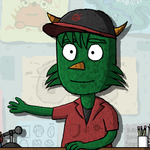 Adobe Community
Adobe Community
Turn on suggestions
Auto-suggest helps you quickly narrow down your search results by suggesting possible matches as you type.
Exit
- Home
- Character Animator
- Discussions
- Character Animator (December 2018) – Detailed Chan...
- Character Animator (December 2018) – Detailed Chan...
0
Character Animator (December 2018) – Detailed Changes
Adobe Employee
,
/t5/character-animator-discussions/character-animator-december-2018-detailed-changes/td-p/4787764
Nov 30, 2018
Nov 30, 2018
Copy link to clipboard
Copied
Fixed issues
Characterizer
- Fixed a possible crash during a new face capture.
Playback and Recording
- Fixed a crash that might occur while scrubbing through time or using the Record 1-/2-frame Take or Record Take for Work Area commands (or shortcuts) after playback or recording.
- Recording a trigger that has no layers or replays assigned to it now recordings the trigger.
- Switching away from the application during recording no longer stops recording.
Dynamic Link
- Character Animator scenes (from different Character Animator projects) in a Premiere Pro project no longer go offline when the project is reopened. This change requires a corresponding updated Premiere Pro version as well.
Known issues
- If a scene doesn’t render (i.e., Scene panel shows only the current background color), try clicking the Refresh Scene button at the bottom of the Scene panel. If that still doesn’t work, try Option-clicking (Mac) / Alt-clicking (Windows) the Refresh Scene button. If the scene still does not render correctly, please file a bug report and attach a project or artwork file.
- In an Illustrator file, layers and groups with “Guide” in their name will not be interpreted as guides/handles, and their content still render even if muted in the artwork file. Only paths are supported at this time.
- Applying the Draggable handle tag to the top-level origin handle for a puppet won’t allow the puppet to be dragged in the scene.
Workaround: If the puppet’s layers are enclosed in a single top-level group, apply the Draggable tag to that group’s origin. - Background syncing, backup, or virus checking programs might cause error messages in Character Animator if the current project’s files are being synced, backed up, or scanned at the same time. Avoid creating projects in these background-synced locations, or at least avoid working in a project while syncing is enabled.
Workaround: Exclude the folder containing your Character Animator projects (by default, located in your user Documents/Adobe/Character Animator (Mac) or Documents\Adobe\Character Animator (Win) folder) and its subfolders from virus scanning, or at least for write operations. - Adobe Media Encoder (AME) can render a stale (non-current) version of a scene if it was added via the Add Source button and the scene was subsequently modified while Character Animator was connected to AME.
- Face, Keyboard Triggers, and Lip Sync behaviors in projects and puppet files created in earlier (Beta) versions of Character Animator might appear as obsolete (with “(obsolete)” after their names) when opened in the latest Character Animator, but will still work. However, they will not benefit from improvements made in newer versions.
Workaround: If you wish to update the obsolete behaviors to the latest versions, and do not have any recordings for them, or if you don't mind losing the recordings, select the puppet in the Project panel, remove the obsolete behaviors, and add the newer versions of the behaviors. For the obsolete Keyboard Triggers, replace with Triggers.
If you update the behaviors for a puppet imported from a .puppet file, be sure to export a new .puppet file to share with other users that have a similar version of Character Animator; they cannot be imported into earlier versions of Character Animator once re-exported.
Community guidelines
Be kind and respectful, give credit to the original source of content, and search for duplicates before posting.
Learn more
Have something to add?
Join the conversation
Resources
Get Started
Copyright © 2023 Adobe. All rights reserved.
